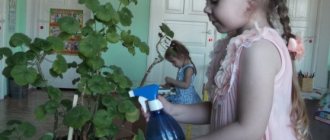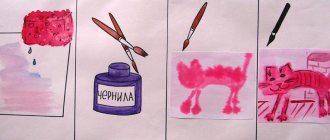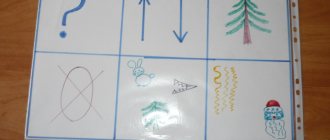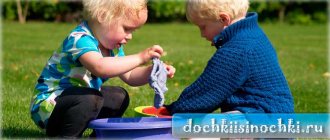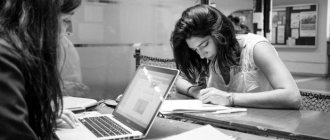Innovative technologies in musical education of preschool children
Music plays an important role in the education of preschoolers. This type of art has special properties that have a beneficial effect on the psychology of children. It is not for nothing that musicologist and teacher Vyacheslav Vyacheslavovich Medushevsky calls music the mirror of the human soul: a person’s feelings, experiences, and his vision of the world around him resonate in it. Therefore, primary music education is of great importance in the formation of a person’s character.
The role of music education has long been not limited to teaching how to play musical instruments and the basics of singing. Its key task is to develop a creative personality in the child, receptive to beauty and having taste. No matter what profession a person chooses in the future, creative, lively thinking will be a reliable help in any activity.
For example, “Program of education and training in kindergarten” edited by M.A. Vasilyeva, V.V. Gerbova, T.S. Komarova includes the development of preschoolers’ ear for music, singing voice, ability to dance, and play children’s musical instruments. In addition to generally accepted goals, the program targets the child’s urgent needs, such as the manifestation of individual abilities in contact with music, demonstration of primary creativity and creative abilities, assistance in self-knowledge and work with the inner world.
Music education to develop abilities
It is no secret that a person has a need to express himself through emotions and movements. The optimal way to satisfy it is musical and creative activity. More and more experts are inclined to believe that music training in the modern world is regarded not as additional, but as necessary. Gradually, it becomes not only an opportunity for cultural enrichment and familiarization with aesthetics, but also an effective way to develop various abilities in a person and their implementation in life.
New approaches to music education entail other, more effective, pedagogical technologies. It is important to understand that the main function of music is for people to communicate with each other. In this case, the authoritarian approach and the corresponding teaching methods are not suitable; the creative, spiritual and practical principle should prevail. This is possible by organizing artistic activities for preschoolers through listening to music, performing it and creating it. According to the writer Michel de Montaigne, “where there is benefit for children, there should also be pleasure for them.” Thus, musical creativity should turn into a pleasant, joyful activity for children, opening up opportunities for communication.
How to get kids interested in music
The key question that arises among music education teachers is how to captivate preschoolers with music. This can be done by instilling in children an understanding and feeling that music is an integral part of their lives. Therefore, integrated methods that combine general pedagogical and social aspects predominate in teaching. Introducing to art requires an individual approach and is closely connected with the self-determination of the individual. Therefore, when choosing forms of work, the musical and artistic director should focus on developing the following qualities and abilities in children:
- sensory perception of the world;
- associative thinking;
- expressive abilities: speech, vocal, plastic, instrumental;
- sense of rhythm: temporal, spatial, plastic, musical;
- the ability to distinguish and express various concepts using artistic means: big-small, good-evil, quiet-loud, etc.
- ways of expression: movements, gestures, onomatopoeia, etc.;
- joyful, lively, playful feeling of the surrounding reality.
To help develop the practice of musical interaction with preschoolers, it is effective to use the methods and developments of such teachers and researchers as T. Borovik, K. Tarasova, T. Tyutyunnikova, O. Radynova, T. Deberdeeva, etc.
One of the premises outlined in the works of these authors is that the basis of innovative approaches in music education is collective activity. It may include singing, improvised dance movements, pantomime, narration, and small theatrical performances.
Innovative forms of music education in practice
There are various types of innovative methods used in musical and artistic work with preschool children. I will give the most popular and effective of them.
Communicative dances
The use of dance in the process of getting to know and learning about music allows children to develop communication skills, work on their sense of form, develop coordination and a sense of rhythm.
Musical and speech outdoor games
Such games are based on the relationship between speech, music and movement. This is their particular benefit for the development of a child, since the formation of movement in a person occurs with the participation of speech, and speech with the participation of movement. Musical and speech games allow you to develop dexterity, precision of movements, and reaction.
Finger games
Finger games are the first experiments in performing artistry, in which the performance is complemented by rhythmic and sound modulations of spoken language. They represent a theater in miniature, where the “actors” are the fingers. The text is not interpreted literally, but in the form of certain gestures and symbolism. This improves the functioning of the muscular system, fine motor skills, diction, tactile sensitivity, anticipates consciousness (due to the rapid change of movements), and increases the level of organization of children. Also, working on texts with gesture drawings contributes to the development of abstract thinking, imagery and associativity.
Rhythmic recitation to music
Rhythmic declamation represents the unity of music and poetry. Within the framework of this technique, the text is not sung, but rhythmically recited - clearly, with intonation, pronounced. Refusal to sing is justified, on the one hand, by simplifying the process - it is easier for a child to speak than to sing. On the other hand, it develops intonational thinking, within the framework of which hearing and speech interact. To learn to sing, children need to hear their speech and learn to control it.
Games with sounds
In working with sounds, the following areas are conventionally distinguished:
- “sounding gestures” and body music;
- noise instruments: both homemade and professional.
For example, the game “Listen to Yourself” allows children to understand that the human body is also a musical instrument in its own way. With its help - with your voice, hands, feet, lips - you can reproduce many sounds. The purpose of such a game is to understand that man and nature are closely connected.
Elementary music playing
Musical instruments, primarily noise instruments, are often used to teach children music. They are ideal for preschoolers due to their ease of handling and attractiveness. However, modern techniques suggest using, in addition to specialized tools, homemade ones, as well as a variety of household appliances. In this way, children learn to understand the world through sound and relate these concepts to each other.
Elementary music playing allows you to develop:
- musicality;
- timbre hearing;
- subtlety of perception;
- associativity;
- artistry.
All these forms can be combined and present within one lesson. Depending on the goals and objectives, the teacher can supplement them with various elements. This methodological modeling of the material has a certain benefit: the techniques are familiar to children, but are repeated in a new, unfamiliar version.
During teaching, it is important that the teacher’s ability to involve children in the game, to create a fascinating atmosphere of fairy tales, riddles, and magic. To do this, he needs to have well-developed speech, well-developed intonations, artistry, good plasticity and expressive facial expressions.
Results of application of innovative technologies
The practical use of these technologies makes it possible to obtain the following results:
- creating a positive atmosphere in music classes and events;
- creating a good mood in children and relaxation in classes, the gradual disappearance of uncertainty and fear;
- children's interest in the material being studied, lack of coercion;
- successful acquisition by children of initial musical knowledge, development of musical and creative abilities, knowledge of themselves and the world around them in the course of natural “communication” with music;
- finding the music director in constant creative search, the process of creating new teaching methods. Children's response and interest bring pleasure and a feeling of “giving back.”
Literature:
- Vetlugina N.A., Keneman A.V. Theory and methods of music education in kindergarten. – M: Enlightenment. 1983
- Deberdeeva T.Kh. New values of education in the information society / T. Kh. Deberdeeva // Innovations in education. - 2010. - No. 3.
- Barenboim L.A. System of musical education by K. Orff. M.-L., 1970
- Borovik T.A. Paths of pedagogical creativity. Musical director. — M.: LLC Publishing House “Education of Preschool Children”. 2004 No. 1 p.9-25, No. 2 p. 18-33, No. 4 p. 29-41, No. 5 p. 23-28, No. 6 p. 9-14.
- Radynova O.P. “Preschool age: how to form the foundations of musical culture” // “Musical Director” 2005.-No. 1
- Tyutyunnikova T. Elementary music-making - “familiar stranger”. Preschool education. 1997 No. 8 p.116-120, 2000 No. 5 p.133-141.
- Burenina A. Communicative dance games for children. – SP: Leningrad Regional Institute for Educational Development. 2004
Modern technologies for conducting music classes in preschool educational institutions
Elena Sorokina
Modern technologies for conducting music classes in preschool educational institutions
" Modern technologies for conducting music classes for preschool children."
musical director Sorokina E. A.
Technology is a clear sequence of specific steps that always leads to a previously known result. technology everywhere; it is part of our daily life . New approaches to music education required the use of effective modern technologies in the development of children’s musicality , focusing the attention of music directors of preschool education on the development of children’s creative and intellectual abilities, correction of the emotional-volitional and motor spheres and aimed at enhancing the child’s cognitive development using a wide range of ICT technologies . Musical lessons become more meaningful, harmonious and productive
Music is a source of special children's joy. To solve the main problem of developing the musical education of preschoolers, I use new technologies in various types of musical activities .
The use of ICT in a preschool institution can significantly revitalize joint educational activities with children. Modern technologies expand the possibilities for presenting musical and didactic material provided for in the educational program of a preschool institution. Having at the same time the additional opportunity to transmit visual information to children.
Musical lessons become more meaningful, harmonious and productive; children are more active in joint discussion of a piece of music .
Carrying out tasks through several types of musical activities : listening to music , singing, musical-rhythmic movements , musical-didactic games , playing children's musical instruments , activate children's attention, as new motives for mastering the proposed material appear.
“Listening to
music ” Technology for developing the perception of music according to the author’s program “ Musical Masterpieces ” by O. P. Radynova is identifying effective ways to introduce children to the art of music , solving issues important for the spiritual development of a person: how to captivate a child with music , teach him to listen, understand, empathize, feel its beauty, form the need to express your impressions in creativity. The author has created a scientifically grounded and methodically structured system for forming the foundations of the musical culture of preschool children, including principles, content, methods and forms of work, taking into account the individual and psychophysiological characteristics of children. Emotionally - expressive explanations of the nature of music , comparisons, metaphors, word-images characterizing changes in mood, poetry, fairy-tale plot form of classes . Using computer presentations on musical fairy tales allows you to enrich the process of emotional and figurative cognition, evokes a desire to listen to music and helps to remember it for a long time.
Presentations are indispensable when introducing children to the works of composers; bright portraits and photographs attract children’s attention, develop cognitive activity and impressions. I studied and analyzed the following methodological literature:
"Childhood with music "
A. G. Gogoberidze, V. A. Derkunskaya
Educational field " Music "
A. G. Gogoberidze, V. A. Derkunskaya
"Song, Dance, March"
O. P. Radynova
"Moods, feelings in music "
O. P. Radynova
"Fairy tale in music . Musical instruments » O. P. Radynova
"Nature and Music "
O. P. Radynova
"Folk lullabies"
O. P. Radynova
" Musical masterpieces . Author's program. Methodological recommendations" by O. P. Radynova
"Singing"
-The development
of musical abilities is closely related to creative activity and is one of the most important tools for achieving the task. Technologies for teaching singing skills by G. A. Struve An original, effective method - “choral solfeggio”, famous musician , teacher, composer, People's Artist of Russia G. A. Struve, is widely known in our country and abroad, built on visual musical exercises , in the form of an entertaining game. Choral solfeggio exercises combine three important components: visual, auditory, and motor. Classes using this method contribute to the active development of musical ear , sense of rhythm, musical memory , harmonic hearing, coordination, and creative abilities of the child. help the teacher in solving the problems of teaching singing skills: emotional responsiveness and perception of musical compositions , modal sense and correct intonation, as well as a sense of rhythm. By gradually mastering the art of singing, the child improves his skills in all types of musical abilities .
The process of dramatizing songs can be presented as part of the training of musical abilities , and as a separate vocal science. Singing forms the articulation of various sounds, improves the mobility and accuracy of movements of the tongue and lips, increases the volume of auditory memory and attention to memorizing the lyrics of songs, and develops a sense of rhythm. To develop a singing voice, breathing exercises should be used. Human health, physical and mental activity largely depend on breathing. Proper breathing is the basis of the life of the body. The respiratory function is extremely important for the normal functioning of a child’s body, especially, since the increased metabolism of a growing organism is associated with increased gas exchange. The respiratory system of a preschool child has not reached full development; children’s breathing is shallow and rapid.
Health-saving technologies according to the method of A. N. Strelnikova for preschool children plays an important role in the health system of preschool children, has a positive effect on metabolic processes, promotes the restoration of the central nervous system, improves the drainage function of the bronchi, restores impaired nasal breathing. Of the four functions of the respiratory organs: breathing, speaking, screaming and singing, singing is the most complex. Consequently, gymnastics restores the most complex function of the singing voice.
"Finger games"
according to the method of E. Zheleznova “The child’s mind is at the tips of his fingers” V. Sukhomlinsky The development of a child’s fine motor skills - fine movements of the hands and fingers is of great importance in psychology and is regarded as one of the indicators of a child’s mental development. Fine motor skills promote concentration, memory training, development of imagination, perception, support cognitive activity and have a beneficial effect on the development of the child’s abilities.
By playing Zheleznova's finger games, the child receives a variety of sensory impressions, he learns to focus on a specific activity , and develops attentiveness. By repeating poetic lines and simultaneously moving their fingers, children develop correct sound pronunciation, the ability to speak quickly and clearly, improve memory, and the ability to coordinate movements and speech. By bending and unbending the fingers with the child, massaging the hands, performing various types of movements, we send impulses to the speech centers. the choice of specific exercises that fit the theme of the lesson , but also the competent weaving of finger play into the structure of work on the development of fine motor skills. At the same time, we must not forget about visual materials using ICT, which make it easier for children to understand the task.
Technologies of musical and rhythmic education (rhythmic plasticity program “Rhythmic mosaic”
A.I. Burenina is aimed at the harmonious development of the individual, the unity of the spiritual and physical);
Goals and objectives:
— Cultivating interest in musical and rhythmic movements .
— Development of emotional responsiveness to music , figurative and playful movements.
— Development of musical ear : musical sensory abilities;
sense of rhythm - the ability to express the rhythmic pulsation of a melody in movement;
- auditory attention - the ability to begin and end movements in accordance with the beginning and end of the music ;
- the ability to change the tempo and nature of movement in accordance with changes in the tempo and nature of the sound.
— Development of the motor sphere - the formation of basic motor skills and abilities, the development of springy, swinging movements, expressive gestures, elements of dance movements; development of expressiveness of movements, the ability to convey images of familiar animals and characters in facial expressions and pantomime.
— Cultivation of sociability, the ability to make contact with adults or children.
— Development of basic spatial orientation skills: the ability to stand one after another, move in a “flock”
behind the leader, in a circle, forward, backward.
How to instill in children a love of learning musical and rhythmic movements from a young age? Of course, through play, so that in an entertaining, playful situation the child performs movements easily and naturally. The visual-visual, motor method is used when showing games, dances, and individual dance elements. The verbal method is a method that is very important, because without a correct, clear explanation it is impossible to achieve a positive result.
Having studied a lot of materials on the topic, I try to adhere to the Methods and developments of T. Borovik, A. Burenina and T. Sauko, T. Tyutyunnikova, O. Radynova, M. Kartushina, Suvorova; constant reading and study of professional periodicals “ Musical Director ”
,
“Hoop”
,
“Preschool Education”
- all this, undoubtedly, turned out to be very interesting and useful for me, expanded my professional horizons and was reflected in practical activities.
"Elementary music playing with preschoolers"
promotes the development of their creative abilities, natural
musicality , creates conditions for a broad orientation in music and the accumulation of a stock of musical impressions , helps to successfully solve the problems of the preschool education program); Technologies of elementary music-making with preschool children (the use of technology by T. E. Tyutyunnikova makes it possible to:
- develop the individuality of children, their ability to improvise , creativity, and the ability to fantasize;
— educate and develop musical abilities in a fascinating aesthetic game with instruments;
- pay attention to the emotional world of children, their ability to empathize;
— develop communication and cooperation skills in a group;
— training of various types of attention, accurate and quick reactions, listening skills, and active perception.
Eurythmy is the art of movement, based on the laws of speech and music and is one of the ways of expressing musical movement in space. Eurythmy develops the musical and creative abilities of children, the emotional sphere, moral and communicative qualities, and the mental potential of preschoolers, which has a beneficial effect on the culture of children's movement. The purpose of eurythmy is to develop a culture of movement in preschool children.
Eurythmy classes Imitating the movements of the teacher, children transform into the images of various plants and animals, experience natural phenomena, and imitate the activities of people. Poems and music are chosen in accordance with the seasonal state of nature. In musical eurythmy, children learn to move in the character of music , learn to feel the movement of others. Play is the leading activity of a preschooler, and it is this type of activity that became the basis for the development of special eurythmy exercises.
The main feature of eurythmy exercises is the emphasis on teaching musical and rhythmic movements , on the analysis of internal processes: mental, emotional.
Eurythmy includes:
- rhythm games;
- exercises to develop fine motor skills, gross motor skills;
(exercise to develop coordination, balance, foot dexterity)
;
— spatial orientation;
- social games (interaction with a partner, a subgroup of children and the entire group as a single team);
— improvisational movement compositions with musical accompaniment;
— igroplasty — special exercises for the development of muscle flexibility, strength in figurative and playful motor tasks;
— game dances — dance steps aimed at developing and improving dance movements.
Learned musical-rhythmic etudes and compositions are widely used in direct educational activities in music , physical education, as well as in all routine aspects of a preschool educational organization.
Practical experience gained in working with preschoolers allows us to conclude that eurythmy has certain untapped reserves in increasing the effectiveness of the art education system of the younger generation.
Technology for designing a musically enriched environment.
When developing the material and content of musical didactic games aimed at developing musical abilities, it is necessary to take into account the characteristics of the musical development of a preschooler. When selecting musical works for games, it is necessary to remember that they must be accessible to the perception of a child of senior preschool age. When organizing any musical game , including musical didactic , it is important to consider each child as an individual capable of expressing his “I”
.
Having studied a lot of materials on the topic, I try to adhere to the Methods and developments of T. Borovik, A. I. Burenina and T. Sauko, T. E. Tyutyunnikova, the method of Carl Orff, “
Musical Masterpieces ” by O. P. Radynova, M. Kartushina, Program Leaders on
musical education and teaching in kindergarten (edited by N.A. Vetlugina, N.E. Veraksa, I. Kaplunova Suvorova; constant reading and study of professional periodicals “
Musical Director ” ,
“Hoop”
,
“Preschool Education”
- all this, undoubtedly, turned out to be very interesting and useful for me, expanded my professional horizons and was reflected in practical activities
The use of various methods and technologies described in this work awakens curiosity and makes it relatively easy to remember the proposed musical material .
Innovative approaches to organizing music education in preschool educational institutions.
Coordination and movement games (musical and speech)
Active exercises prepare children for spontaneous motor expressions, teach them to depict moods and sounds using elementary movements - clapping, clicking, stamping.
Finger games (musical and speech)
represent the first experiments in performing artistry. This form is aimed at developing coordination freedom of movement and the ability for motor improvisation.
Speech music making -
These are speech exercises that develop a child’s sense of rhythm, promote the formation of correct articulation, and show a variety of dynamic shades and tempos. This form of work is suitable for general musical development.
Poetic music making —
helps children experience the harmonious sound of poetry and music.
Games with sounds
: - sounding gestures and music of my body;
noise instruments (traditional and homemade) and music born from noise.
Elementary music playing.
In modern musical methodology, it is the study of sound and children’s knowledge of the world through sound, the creation of a different image of a wide variety of everyday objects that are increasingly being developed. They are the members of an amazing orchestra!
I will note such forms of work as:
Games with tools
Animated dances and flash mobs.
Quests
Music therapy
Interaction with teachers.
Interaction with parents.
Organizing work with families involves the use of various forms and methods of communication with parents, both traditional and innovative (master classes, literary lounges, the use of ICT for the mutual enrichment of pedagogical skills, promotions, on-site competitions, projects, interactive leisure activities).
Application of ICT
— The use of multimedia technologies in music classes is a universal means of visualization, which helps broaden the horizons of students, encourage children to independently obtain information, develop interest in the subject, making learning bright, memorable, and interesting. ICT can be used in music classes in various ways: demonstrating presentations, making virtual trips, using musical and didactic games. ICT provides the greatest opportunities for successful joint creativity between educators, teachers and preschoolers, which has a positive effect on the emotional atmosphere and makes the creative process exciting and effective.
Thus,
the goal of managing innovation processes in preschool educational institutions is to ensure the implementation of innovative strategies, the functioning of innovative structural units and the entire teaching staff to achieve high efficiency of education and improve its quality. Being a specific type of human thinking, music has the main goal - communication, and teachers should study and accumulate your experience for the further development of the child’s harmonious personality. Preschoolers learn about themselves and the world around them through playful, joyful and natural communication with music.
